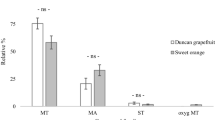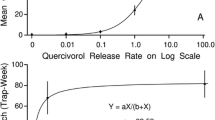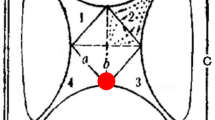Abstract
Ambrosia beetles in the cryptic species complex Euwallacea nr. fornicatus vector a fungal pathogen responsible for Fusarium dieback, a disease that impacts avocado (Persea americana), woody ornamentals, and numerous native trees in the USA (California, Florida), Israel, and other countries. Currently, these pests are detected with quercivorol lures (containing p-menth-2-en-1-ol isomers), but recent research identified an essential oil enriched in (-)-α-copaene as a new attractant. In this study, lure longevity and efficacy were assessed in three 12-week field tests conducted in Florida by deploying traps baited with quercivorol, α-copaene, and a combination of the two. A fourth test compared different formulations of quercivorol. Concurrent with field experiments, gas chromatographic analyses were conducted to quantify initial lure contents as well as volatile emissions from lures field-aged for 12 weeks. In all tests, the lure combination captured significantly more E. nr. fornicatus than the individual lures; and in two trials, synergistic attraction was observed. Field life of the combination lure was 12 weeks; longevity of single lures varied from 9 to 12 weeks. Twelve terpenoids were detected from the α-copaene-enriched oil, suggesting there may be additional attractants. Analysis of the quercivorol lure showed it contained 88% trans- and 9% cis-p-menth-2-en-1-ol. Results indicate that the combination of quercivorol and α-copaene provides a long-lasting, effective lure for early detection of E. nr. fornicatus in Florida. Further research is needed to determine which isomer of p-menth-2-en-1-ol is attractive to Florida E. nr. fornicatus, and if other members of the species complex are attracted to (-)-α-copaene.




Similar content being viewed by others
References
Adams RP (2007) Identification of essential oil components by gas chromatography/mass spectrometry, 4th edn. Allured Publishing Corp, Carol Stream
Ali A, Tabanca N, Demirci B, Baser KHC, Ellis J, Gray S, Lackey BR, Murphy C, Khan IA, Wedge DE (2013) Composition, mosquito larvicidal, biting deterrent and antifungal activity of essential oils of different plant parts of Cupressus arizonica var. glabra (‘Carolina Sapphire’). Nat Prod Commun 8:257–260
Al-Rehaily AJ, Alqasoumi SI, Yusufoglu HS, Al-Yahya MA, Demirci B, Tabanca N, Wedge DE, Demirci F, Bernier UR, Becnel JJ, Temel HE, Baser KHC (2014) Chemical composition and biological activity of Haplophyllum tuberculatum Juss. essential oil. J Essent Oil Bear Plant 3:452–549
Atkinson TH, Carrillo D, Duncan RE, Peña JE (2013) Occurrence of Xyleborus bispinatus (Coleoptera: Curculionidae: Scolytinae) Eichhoff in southern Florida. Zootaxa 3669:096–100
Bateman MA, Morton TC (1981) The importance of ammonia in proteinaceous attractants for fruit flies (family: Tephritidae). Aust J Agric Res 32:883–903
Blair M, Tuck KL (2009) A new diastereoselective entry to the (1S, 4R)- and (1S, 4S)-isomers of 4-isopropyl-1-methyl-2-cyclohexen-1-ol, aggregation pheromones of the ambrosia beetle Platypus quercivorus. Tetrahedron Asymmetry 20:2149–2153
Blythe EK, Tabanca N, Demirci B, Tsikolia M, Bloomquist JR, Bernier UR (2016) Lantana montevidensis essential oil: chemical composition and mosquito repellent activity against Aedes aegypti. Nat Prod Commun 11:1713–1716
Boland JM (2016) The impact of an invasive ambrosia beetle on the riparian habitats of the Tijuana River Valley, California. PeerJ 4:e2141
Brar GS, Capinera JL, McLean S, Kendra PE, Ploetz RC, Peña JE (2012) Effect of trap size, trap height and age of lure on sampling Xyleborus glabratus (Coleoptera: Curculionidae: Scolytinae), and its flight periodicity and seasonality. Florida Entomol 95:1003–1011
Byers JA, Maoz Y, Levi-Zada A (2017) Attraction of the Euwallacea sp. near fornicatus (Coleoptera: Curculionidae) to quercivorol and to infestation in avocado. J Econ Entomol 110:1512–1517
Cahn RS, Ingold C, Prelog V (1966) Specification of molecular chirality. Angew Chem Int Ed Engl 5:385–415
Campbell P, Geering A (2011) Biosecurity capacity building for the Australian avocado industry—laurel wilt. In: Proceedings VII world avocado congress 2011 (Actas VII Congreso Mundial del Aguacate 2011). Cairns, Australia. 5–9 September 2011. http://www.avocadosource.com/WAC7/Section_03/CampbellPaul2011.pdf
Carrillo D, Duncan RE, Peña JE (2012) Ambrosia beetles (Coleoptera: Curculionidae: Scolytinae) that breed in avocado wood in Florida. Florida Entomol 95:573–579
Carrillo D, Narvaez T, Cossé AA, Stouthamer R, Cooperband M (2015) Attraction of Euwallacea nr. fornicatus (Coleoptera: Curculionidae: Scolytinae) to lures containing quercivorol. Florida Entomol 98:780–782
Carrillo D, Cruz LF, Kendra PE, Narvaez TI, Montgomery WS, Monterroso A, De Grave C, Cooperband MF (2016) Distribution, pest status, and fungal associates of Euwallacea nr. fornicatus in Florida avocado groves. Insects 7:55
Carroll JF, Tabanca N, Kramer M, Elejalde NM, Wedge DE, Bernier UR, Coy M, Becnel JJ, Demirci B, Baser KHC, Zhan J, Zhan S (2011) Essential oils of Cupressus funebris, Juniperus communis, and J. chinensis (Cupressaceae) as repellents against ticks (Acari: Ixodidae) and mosquitoes (Diptera: Culicidae) and as toxicants against mosquitoes. J Vector Ecol 36:258–268
Chemical Abstracts Service. https://scifinder.cas.org. Accessed on 26 Jan 2018
Cooperband MF, Stouthamer R, Carrillo D, Eskalen A, Thibault T, Cossé AA, Castrillo LA, Vandenberg JD, Rugman-Jones PF (2016) Biology of two members of the Euwallacea fornicatus species complex (Coleoptera: Curculionidae: Scolytinae), recently invasive in the USA, reared on an ambrosia beetle artificial diet. Agric For Entomol 18:223–237
Cooperband MF, Cossé AA, Jones TH, Carrillo D, Cleary K, Canlas I, Stouthamer R (2017) Pheromones of three ambrosia beetles in the Euwallacea fornicatus species complex: ratios and preferences. PeerJ 5:e3957
Danthanarayana W (1968) The distribution and host-range of the shot-hole borer (Xyleborus fornicatus Eichh.) of tea. Tea Q 39:61–69
Dodge C, Coolidge J, Cooperband M, Cossé A, Carrillo D, Stouthamer R (2017) Quercivorol as a lure for the polyphagous and Kuroshio shot hole borers, Euwallacea spp. nr. fornicatus (Coleoptera: Scolytinae), vectors of Fusarium dieback. PeerJ 5:e3656
Eskalen A, Stouthamer R, Lynch SC, Rugman-Jones PF, Twizeyimana M, Gonzalez A, Thibault T (2013) Host range of Fusarium dieback and its ambrosia beetle (Coleoptera: Scolytinae) vector in southern California. Plant Dis 97:938–951
Eskalen A (2017) Known suitable reproductive hosts of shot hole borer-Fusarium dieback in California. http://eskalenlab.ucr.edu/shotholeborerhosts.html. Accessed 28 Jan 2018
FFNSC 3 (2015) Flavors and fragrances of natural and synthetic compounds 3, mass spectral database. Wiley, Hoboken
Fraedrich SW, Harrington TC, Rabaglia RJ, Ulyshen MD, Mayfield AE III, Hanula JL, Eickwort JM, Miller DR (2008) A fungal symbiont of the redbay ambrosia beetle causes a lethal wilt in redbay and other Lauraceae in the southeastern USA. Plant Dis 92:215–224
Freeman S, Protasov A, Sharon M, Mohotti K, Eliyahu M, Okon-Levy N, Maymon M, Mendel Z (2012) Obligate feed requirement of Fusarium sp. Nov., an avocado wilting agent, by the ambrosia beetle Euwallacea aff. fornicata. Symbiosis 58:245–251
García-Avila CDJ, Trujillo-Arriaga FJ, López-Buenfil JA, González-Gómez R, Carrillo D, Cruz LF, Ruiz-Galván I, Quezada-Salinas A, Acevedo-Reyes N (2016) First report of Euwallacea nr. fornicatus (Coleoptera: Curculionidae) in Mexico. Florida Entomol 99:555–556
Gillette NE, Mehmel CJ, Mori SR, Webster JN, Wood DL, Erbilgin N, Owen DR (2012) The push-pull tactic for mitigation of mountain pine beetle (Coleoptera: Curculionidae) damage in lodgepole and whitebark pines. Environ Entomol 41:1575–1586
Hanula JL, Mayfield AE III, Fraedrich SW, Rabaglia RJ (2008) Biology and host associations of the redbay ambrosia beetle (Coleoptera: Curculionidae: Scolytinae), exotic vector of laurel wilt killing redbay trees in the southeastern United States. J Econ Entomol 101:1276–1286
Hardt IH, Rieck A, Fricke C, Koening WA (1995) Enantiomeric composition of sesquiterpene hydrocarbons of the essential oil of Cedrela odorata L. Flavour Fragr J 10:165–171
Hazarika LK, Bhuyan M, Hazarika BN (2009) Insect pests of tea and their management. Ann Rev Entomol 54:267–284
Hughes MA, Martini X, Kuhns E, Colee J, Mafra-Neto A, Stelinski LL, Smith JA (2017) Evaluation of repellents for the redbay ambrosia beetle, Xyleborus glabratus, vector of the laurel wilt pathogen. J Appl Entomol 141:653–664
Hulcr J, Dunn RR (2011) The sudden emergence of pathogenicity in insect-fungus symbioses threatens naïve forest ecosystems. Proc R Soc B Biol Sci 278:2866–2873
Inch SA, Ploetz RC, Blanchette R, Held B (2012) Histological and anatomical responses in avocado, Persea americana, induced by the vascular wilt pathogen, Raffaelea lauricola. Botany 90:627–635
Jones ME, Kabashima J, Eskalen A, Dimson M, Mayorquin JS, Carrillo JD, Hanlon CC, Paine TD (2017) Evaluations of insecticides and fungicides for reducing attack rates of a new invasive ambrosia beetle (Euwallacea sp., Coleoptera: Curculionidae: Scolytinae) in infested landscape trees in California. J Econ Entomol 110:1611–1618
Karunaratne WS, Kumar V, Pettersson J, Kumar NS (2008) Response of the shot-hole borer of tea, Xyleborus fornicatus (Coleoptera: Scolytidae) to conspecifics and plant semiochemicals. Acta Agric Scand Sect A—Anim Sci 58:345–351
Kashiwagi T, Nakashima T, Tebayashi S-I, Kim C-S (2006) Determination of the absolute configuration of quercivorol, (1S, 4R)-p-menth-2-en-1-ol, an aggregation pheromone of the ambrosia beetle Platypus quercivorus (Coleoptera: Platypodidae). Biosci Biotechnol Biochem 70:2544–2546
Kasson MT, O’Donnell K, Rooney AP, Sink S, Ploetz RC, Ploetz JN, Konkol JL, Carrillo D, Freeman S, Mendel Z, Smith JA, Black AW, Hulcr J, Bateman C, Stefkova K, Campbell PR, Geering ADW, Dann EK, Eskalen A, Mohotti K, Short DPG, Aoki T, Fenstermacher KA, Davis DD, Geiser DM (2013) An inordinate fondness for Fusarium: phylogenetic diversity of fusaria cultivated by ambrosia beetles in the genus Euwallacea on avocado and other plant hosts. Fungal Genet Biol 56:147–157
Kendra PE, Montgomery WS, Mateo DM, Puche H, Epsky ND, Heath RR (2005) Effect of age on EAG response and attraction of female Anastrepha suspensa (Diptera: Tephrididae) to ammonia and carbon dioxide. Environ Entomol 34:584–590
Kendra PE, Montgomery WS, Niogret J, Peña JE, Capinera JL, Brar G, Epsky ND, Heath RR (2011) Attraction of the redbay ambrosia beetle, Xyleborus glabratus, to avocado, lychee, and essential oil lures. J Chem Ecol 37:932–942
Kendra PE, Niogret J, Montgomery WS, Sanchez JS, Deyrup MA, Pruett GE, Ploetz RC, Epsky ND, Heath RR (2012) Temporal analysis of sesquiterpene emissions from manuka and phoebe oil lures and efficacy for attraction of Xyleborus glabratus (Coleoptera: Curculionidae: Scolytinae). J Econ Entomol 105:659–669
Kendra PE, Montgomery WS, Niogret J, Epsky ND (2013) An uncertain future for American Lauraceae: a lethal threat from redbay ambrosia beetle and laurel wilt disease (a review). Special issue: the future of forests. Am J Plant Sci 4:727–738
Kendra PE, Montgomery WS, Niogret J, Pruett GE, Mayfield AE III, MacKenzie M, Deyrup MA, Bauchan GR, Ploetz RC, Epsky ND (2014a) North American Lauraceae: Terpenoid emissions, relative attraction and boring preferences of redbay ambrosia beetle, Xyleborus glabratus (Coleoptera: Curculionidae: Scolytinae). PLoS ONE 9(7):e102086
Kendra PE, Montgomery WS, Niogret J, Schnell EQ, Deyrup MA, Epsky ND (2014b) Evaluation of seven essential oils identifies cubeb oil as most effective attractant for detection of Xyleborus glabratus. J Pest Sci 87:681–689
Kendra PE, Narvaez TI, Montgomery WS, Carrillo D (2015a) Ambrosia beetle communities in forest and agricultural ecosystems with laurel wilt disease (D3524). In: 53rd Annual Meeting of the Entomological Society of America, Minneapolis, MN, USA 15–18 November 2015. https://esa.confex.com/esa/2015/webprogram/Paper99702.html
Kendra PE, Niogret J, Montgomery WS, Deyrup MA, Epsky ND (2015b) Cubeb oil lures: Terpenoid emissions, trapping efficacy, and longevity for attraction of redbay ambrosia beetle (Coleoptera: Curculionidae: Scolytinae). J Econ Entomol 108:350–361
Kendra PE, Montgomery WS, Deyrup MA, Wakarchuk D (2016a) Improved lure for redbay ambrosia beetle developed by enrichment of α-copaene content. J Pest Sci 89:427–438
Kendra PE, Montgomery WS, Schnell EQ, Deyrup MA, Epsky ND (2016b) Efficacy of α-copaene, cubeb, and eucalyptol lures for detection of redbay ambrosia beetle (Coleoptera: Curculionidae: Scolytinae). J Econ Entomol 109:2428–2435
Kendra PE, Owens DR, Montgomery WS, Narvaez TI, Bauchan GR, Schnell EQ, Tabanca N, Carrillo D (2017) α-Copaene is an attractant, synergistic with quercivorol, for improved detection of Euwallacea nr. fornicatus (Coleoptera: Curculionidae: Scolytinae). PLoS ONE 12(6):e0179416
King CBR (1940) Notes on the shot-hole borer of tea Xyleborus fornicatus Eichhoff fornicatior Eggers. Tea Q 13:111–116
Kuhns EH, Tribuiani Y, Martini X, Meyer WL, Peña J, Hulcr J, Stelinski LL (2014) Volatiles from the symbiotic fungus Raffaelea lauricola are synergistic with manuka lures for increased capture of the redbay ambrosia beetle Xyleborus glabratus. Agric Forest Entomol 16:87–94
Mendel Z, Protasov A, Sharon M, Zveibil A, Ben Yehuda S, O’Donnell K, Rabaglia R, Wysoki M, Freeman S (2012) An Asian ambrosia beetle Euwallacea fornicatus and its novel symbiotic fungus Fusarium sp. pose a serious threat to the Israeli avocado industry. Phytoparasitica 40:235–238
Miller DR, Rabaglia RJ (2009) Ethanol and (−)-α-pinene: Attractant kairomones for bark and ambrosia beetles in the southeastern US. J Chem Ecol 35:435–448
Mori K (2006) Synthesis of (1S, 4R)-4-isopropyl-1-methyl-2-cyclohexen-1-ol, the aggregation pheromone of the ambrosia beetle Platypus quercivorus, its racemate, (1R, 4R)- and (1S,4S)-isomers. Tetrahedron Asymmetry 17:2133–2142
Niogret J, Kendra PE, Epsky ND, Heath RR (2011) Comparative analysis of terpenoid emissions from Florida host trees of the redbay ambrosia beetle, Xyleborus glabratus (Coleoptera: Curculionidae: Scolytinae). Florida Entomol 94:1010–1017
Niogret J, Epsky ND, Schnell RJ, Boza EJ, Kendra PE, Heath RR (2013) Terpenoid variations within and among half-sibling avocado trees, Persea americana Mill. (Lauraceae). PLoS ONE 8(9):e73601
NIST (2017) The NIST 17 Mass Spectrometer database, Scientific Instrument Services Inc., New Jersey. http://www.sisweb.com/software/ms/nist.htm. Accessed 23 Oct 2017
O’Donnell K, Sink S, Libeskind-Hadas R, Hulcr J, Kasson MT, Ploetz RC, Konkol JL, Ploetz JN, Carrillo D, Campbell A, Duncan RE, Liyanage PNH, Eskalen A, Na F, Geiser DM, Bateman C, Freeman S, Mendel Z, Sharon M, Aoki T, Cossé AA, Rooney AP (2015) Discordant phylogenies suggest repeated host shifts in the Fusarium-Euwallacea ambrosia beetle mutualism. Fungal Genet Biol 82:277–290
Owens D, Montgomery WS, Narvaez TI, Deyrup MA, Kendra PE (2017) Evaluation of lure combinations containing essential oils and volatile spiroketals for detection of host-seeking Xyleborus glabratus (Coleoptera: Curculionidae: Scolytinae). J Econ Entomol 110:1596–1602
Owens D, Cruz LF, Montgomery WS, Narvaez TI, Schnell EQ, Tabanca N, Duncan RE, Carrillo D, Kendra PE (2018) Host range expansion and increasing damage potential of Euwallacea nr. fornicatus (Coleoptera: Curculionidae) in Florida. Florida Entomol 101: in press. Accepted 9 Jan 2018
Ploetz RC, Hughes MA, Kendra PE, Fraedrich SW, Carrillo D, Stelinski LL, Hulcr J, Mayfield AE III, Dreaden TL, Crane JH, Evans EA, Schaffer BA, Rollins J (2017a) Recovery plan for laurel wilt of avocado, caused by Raffaelea lauricola. Plant Health Prog 18:51–77
Ploetz RC, Kendra PE, Choudhury RA, Rollins J, Campbell A, Garrett K, Hughes M, Dreaden T (2017b) Laurel wilt in natural and agricultural ecosystems: Understanding the drivers and scales of complex pathosystems. Special issue: Forest pathology and plant health. Forests 8:48
Rabaglia RJ, Dole SA, Cognato AI (2006) Review of American Xyleborina (Coleoptera: Curculionidae: Scolytinae) occurring north of Mexico, with an illustrated key. Ann Entomol Soc Amer 99:1034–1056
Rabaglia R, Duerr D, Acciavatti R, Ragenovich I (2008) Early detection and rapid response for non-native bark and ambrosia beetles. US Department of Agriculture, Forest Service, Forest Health Protection, Washington, DC. http://www.fs.fed.us/foresthealth/publications/EDRRProjectReport.pdf. Accessed 20 Oct 2017
(SIAP) Servicio de información agroalimentaria y pesquera (2015) Cierre de la producción agrícola por cultivo. http://infosiap.siap.gob.mx/aagricola_siap_gb/ientidad/index.jsp. Accessed 20 Oct 2017
Stouthamer R, Rugman-Jones P, Thu PQ, Eskalen A, Thibault T, Hulcr J, Wang L, Jordal BH, Chen C, Cooperband M, Lin C, Kamata N, Lu S, Masuya H, Mendel Z, Rabaglia R, Sanguansub S, Shih H, Sittichaya W, Zong S (2017) Tracing the origin of a cryptic invader: phylogeography of the Euwallacea fornicatus (Coleoptera: Curculionidae: Scolytinae) species complex. Agric For Entomol 19:366–375
Systat Software (2013) SigmaPlot® 13. User’s guide. Systat Software, Inc., San Jose, CA, USA
Tokoro M, Kobayashi M, Saito S, Kinuura H, Nakashima T, Shoda-Kagaya E, Kashiwagi T, Tebayashi S-I, Kim C-S, Mori K (2007) Novel aggregation pheromone, (1S, 4R)-p-menth-2-en-1-ol, of the ambrosia beetle, Platypus quercivorus (Coleoptera: Platypodidae). Bull For For Prod Res Inst 6:49–57
(USDA-FS) United States Department of Agriculture, Forest Service (2017) Forest Health, Southern Regional Extension Forestry. Distribution of counties with laurel wilt as of 14 April 2017. http://southernforesthealth.net/fungi/laurel-wilt/distribution-map
(USDA-NASS) United States Department of Agriculture, National Agricultural Statistics Service (2017) Noncitrus fruits and nuts 2016 summary. USDA, Washington DC. http://usda.mannlib.cornell.edu/usda/current/NoncFruiNu/NoncFruiNu-06-27-2017.pdf
Van den Dool H, Kratz PD (1963) A generalization of the retention index system including linear temperature programmed gas-liquid partition chromatography. J Chromat A 11:463–471
Acknowledgements
The authors are grateful to Carlos de la Torre, Arnoldo Paniagua, and John Barkett for providing generous access to their groves, to Louis Dessaint (Brooks Tropicals and Florida Avocado Administrative Committee) for assistance in coordinating field operations, and to Xing-Cong Li (School of Pharmacy, University of Mississippi), Richard Mankin (USDA-ARS, Gainesville, FL), Jerome Niogret (Niogret Ecology Consulting, Miami, FL), and the journal editor/referees for critical reviews of an earlier version of this manuscript. Use of a proprietary product does not constitute an endorsement by USDA-ARS.
Funding
Research was supported by USDA-ARS Appropriated Funds (Mitigation of the Invasive Pest Threat from the American Tropics and Subtropics) and an appointment to the ARS Research Participation Agreement between the US Department of Energy (DOE) and the USDA. ORISE is managed by ORAU under DOE contract number DE-SC0014664.
Author information
Authors and Affiliations
Corresponding author
Ethics declarations
Conflict of interest
All authors declare that they have no conflict of interest.
Ethical approval
This article contains field studies that targeted insect pests and did not involve any protected or endangered species.
Additional information
Communicated by J. D. Sweeney.
Special Issue: "Invasive insect pests of forests and urban trees: pathways, early detection, and management".
Rights and permissions
About this article
Cite this article
Owens, D., Kendra, P.E., Tabanca, N. et al. Quantitative analysis of contents and volatile emissions from α-copaene and quercivorol lures, and longevity for attraction of Euwallacea nr. fornicatus in Florida. J Pest Sci 92, 237–252 (2019). https://doi.org/10.1007/s10340-018-0960-6
Received:
Revised:
Accepted:
Published:
Issue Date:
DOI: https://doi.org/10.1007/s10340-018-0960-6




